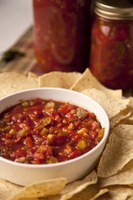Use Research-tested Canning Methods, Recipes
(Click the image below to view a high-resolution image that can be downloaded)
If your vegetable garden was prolific this year or gardeners shared their bounty with you, you may be thinking about canning some produce so you can enjoy it this winter.
The key to canning food safely is using the right equipment.
“You may have seen the ads on TV for new electric multicooker appliances with canning or steam canning features, but some devices may not process the food properly,” North Dakota State University Extension Service food and nutrition specialist Julie Garden-Robinson says.
“In general, the water-bath canning devices from well-known canning manufacturers are safe when used according to the directions,” she adds. “However, the ‘automatic canning machines’ that allow you to can salsa, spaghetti sauce and a few other foods with a touch of a button only can be used safety with the formulations provided in the instruction booklet. You cannot use other recipes in these devices.
“On the other hand, the pressure cooker/canner devices sometimes advertised on TV have not been tested by the National Center for Home Food Preservation for preservation of food,” she notes. “Overall, your best option is to use research-tested canning methods and equipment.”
Improper canning can lead to the growth of bacteria and production of toxins that may cause botulism, a potentially deadly form of food poisoning. Unfortunately, you won’t know whether foods contain the botulism toxin because the foods won’t necessarily have an unusual taste or appearance.
You basically have two types of canning methods: water-bath and pressure canning. Which one you use depends on acidity of the food or mixture of foods you plan to can. Low-acid foods must be processed in a pressure canner.
A low-acid food is one that does not contain enough acid naturally to prevent spores (forms of bacteria) from surviving, growing and producing deadly toxins, even in an airtight environment such as a sealed jar.
All fresh vegetables except for most tomatoes are low-acid foods. Most mixtures of low-acid and acidic foods also are low-acid products unless their recipes include enough lemon juice, citric acid or vinegar to make them acidic foods. Using a pressure canner allows the mixture to reach a higher temperature than a boiling water-bath canner.
The temperature is important, according to the National Center for Home Food Preservation. The temperature in the canner must stay at the proper level for the entire processing time.
Here are some guidelines for canning produce safely:
- Use research-tested recipes and don’t alter ingredient proportions. If you create your own salsa recipe, for instance, and want to preserve it, freezing it is the safest option.
- Acidify tomatoes with bottled lemon juice or citric acid prior to canning. The recommended amount is 1 tablespoon of bottled lemon juice per pint of tomatoes or 2 tablespoons per quart.
- Use Mason-type canning jars of the size the recipe recommends for the specific food you’re canning.
- After filling jars with food, release air bubbles by inserting a flat plastic (not metal) spatula between the food and the inside surface of the jar. Slowly turn the jar and move the spatula up and down to allow air bubbles to escape.
- Use self-sealing lids that consist of a flat lid and a screw band. Tighten the screw band with your fingers, not your muscles, because overtightening can lead to seal failures. You can reuse screw bands, but don’t reuse lids.
- Check the gauge on your pressure canner for accuracy before using it each year. Replace the gauge if it reads high or low by more than 2 pounds at 5, 10 or 15 pounds of pressure.
- Process the filled jars for the proper time and pressure for your altitude.
- Remove the screw bands and test the seals after cooling the jars for 12 to 24 hours.
Visit the NDSU Extension Service’s website at https://www.ag.ndsu.edu/food/food-preservation for more information, including tables with the recommended processing times for pressure canners, and some tasty, research-tested recipes. Click on the category on the left side (computer/tablet) or in the top drop-down menu (smartphone) for your topic of interest.
You also can contact your local office of the NDSU Extension Service for more information.
NDSU Agriculture Communication - Aug. 30, 2016
| Source: | Julie Garden-Robinson, 701-231-7187, julie.garden-robinson@ndsu.edu |
|---|---|
| Editor: | Ellen Crawford, 701-231-5391, ellen.crawford@ndsu.edu |


